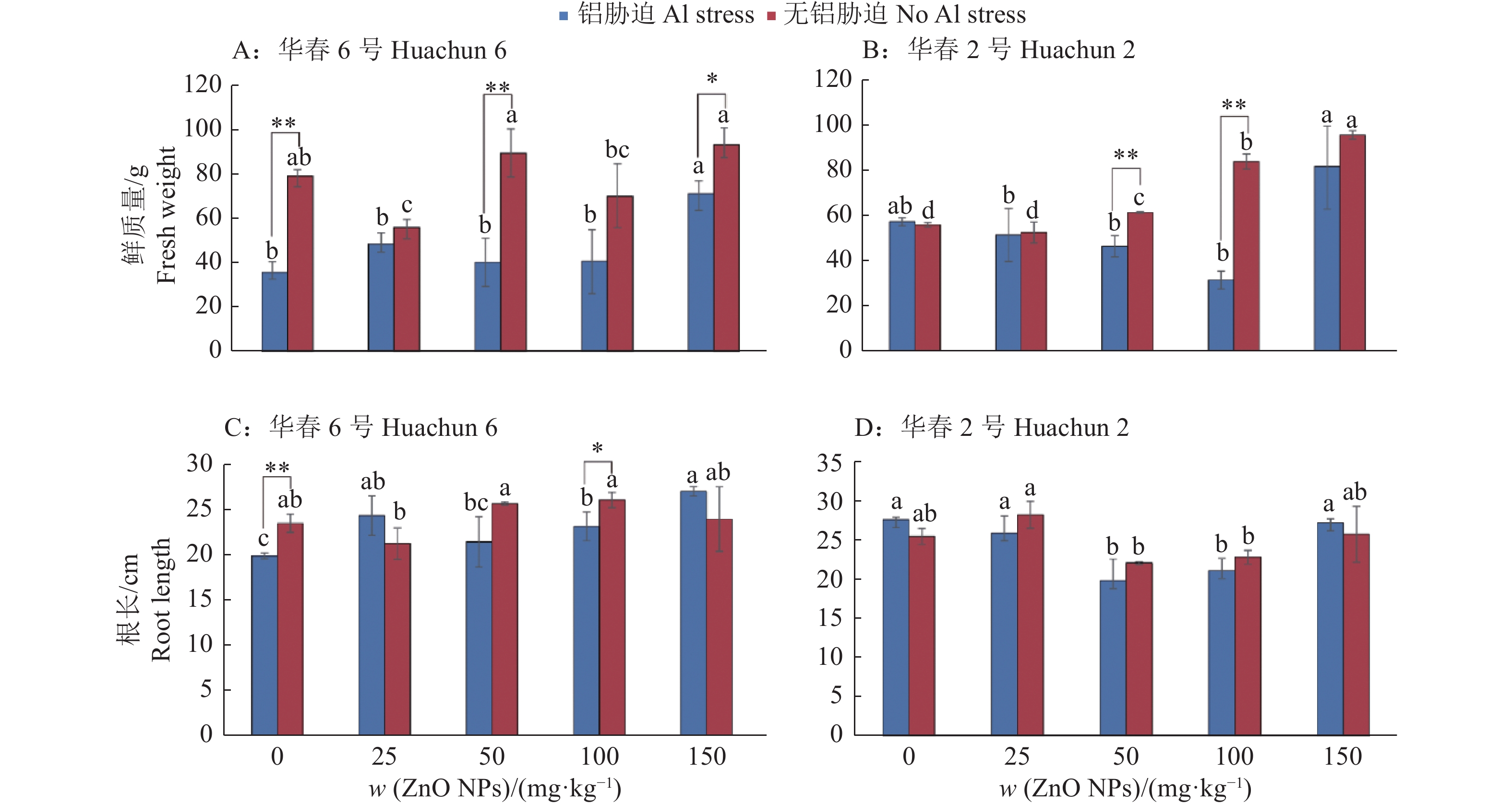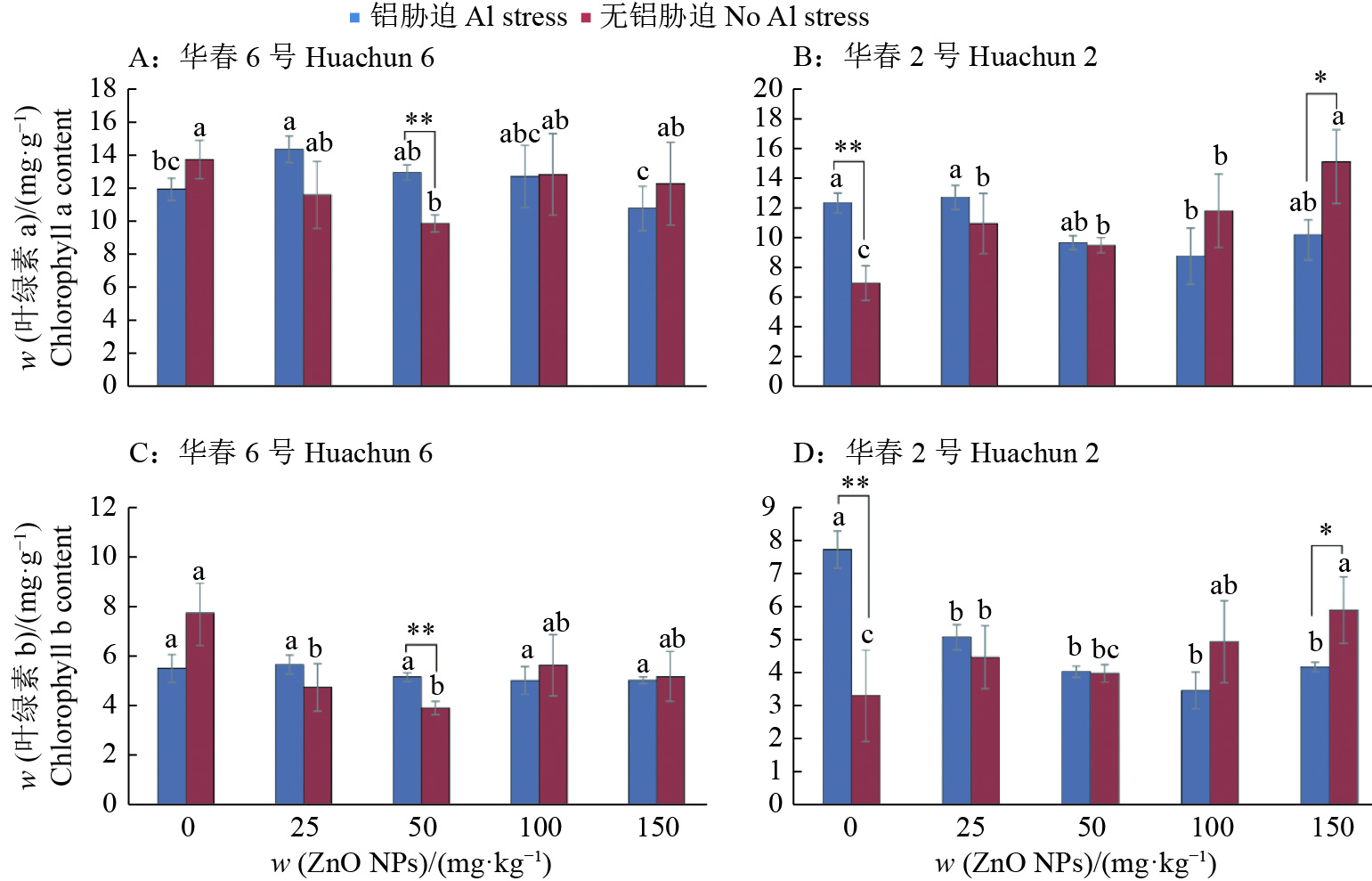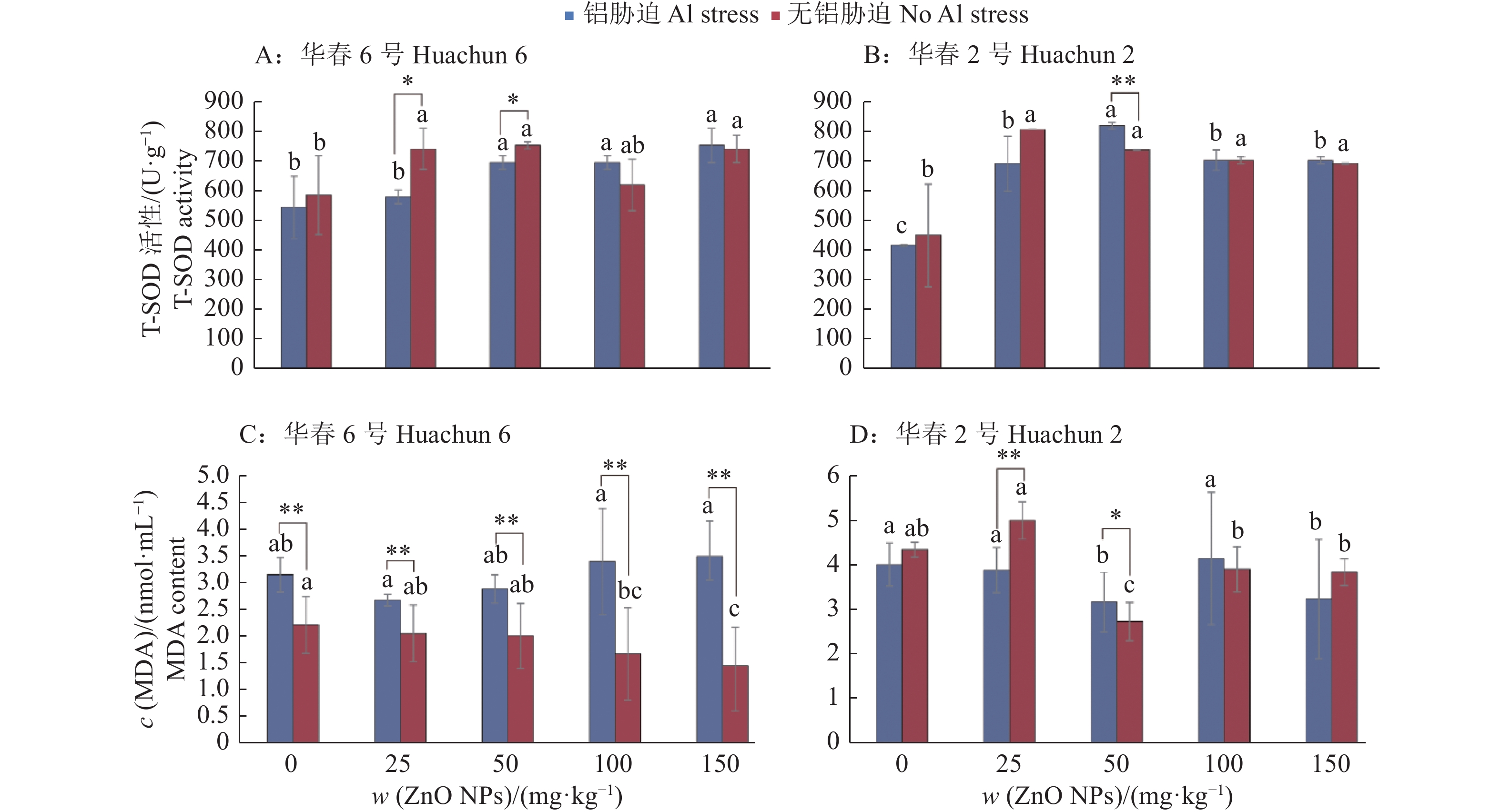Physiological mechanisms of zinc oxide nanoparticles alleviating aluminum stress in soybean
-
摘要:目的
探究在铝(Al)胁迫下不同含量的纳米氧化锌(Zinc oxide nanoparticles,ZnO NPs)对大豆Glycine max (Linn.) Merr.生理特性的影响,为金属纳米材料在农业上的应用提供一定参考。
方法采用盆栽试验,选择耐Al品种‘华春2号’和普通品种‘华春6号’,在0.3 g/kg Al胁迫处理下,施加不同剂量的ZnO NPs(0、25、50、100和150 mg/kg),探究ZnO NPs对大豆生理指标(鲜质量、根长和叶绿素含量)、总超氧化物歧化酶(Total superoxide dismutase,T-SOD)活性和丙二醛(Malondialdehyde,MDA)浓度的影响。
结果Al胁迫显著降低了‘华春6号’的鲜质量和根长,显著增加了其MDA浓度。对于‘华春2号’,Al胁迫显著增加了其叶绿素a和叶绿素b含量,而对其他指标无明显影响。无Al胁迫条件下施用ZnO NPs,均提高了‘华春6号’和‘华春2号’的鲜质量、根长和T-SOD活性。而在Al胁迫下施加不同剂量的ZnO NPs使‘华春6号’的鲜质量和根长分别增加13.2%~100.4%和7.8%~35.8%,而‘华春2号’的鲜质量在150 mg/kg ZnO NPs处理下达到最高值。在25 mg/kg ZnO NPs处理下,‘华春6号’和‘华春2号’的叶绿素a含量均达到最高值。不同含量的ZnO NPs对‘华春6号’的叶绿素b含量无显著影响,而显著降低了‘华春2号’的叶绿素b含量,在100 mg/kg ZnO NPs下达到最低值(3.5 mg/g)。‘华春6号’的T-SOD活性随ZnO NPs含量的增加而增加,‘华春2号’的T-SOD活性在50 mg/kg ZnO NPs时达到峰值(820 U/g),之后随ZnO NPs含量的增加出现下降的趋势。‘华春6号’和‘华春2号’的MDA浓度最小值分别出现在25和50 mg/kg ZnO NPs处理。
结论Al胁迫严重影响大豆的生长发育,施用ZnO NPs可以在一定程度上缓解Al胁迫对大豆植株产生的负面作用,改善植株的生长发育。
Abstract:ObjectiveThis study evaluated the effects of different zinc oxide nanoparticles (ZnO NPs) contents on the growth and physiological characteristics of Glycine max (Linn.) Merr. under aluminum (Al) stress, aiming to provide some reference for the application of metal nanomaterials in agriculture.
MethodIn a pot experiment, Al resistant cultivar ‘Huachun 2’ and Al sensitive cultivar ‘Huachun 6’ were selected and treated with ZnO NPs in various dosages of (0, 25, 50, 100 and 150 mg/kg) under 0.3 g/kg Al stress conditions, to investigate the effects of ZnO NPs on soybean physiological indicators (fresh weight, root length and chlorophyll content), total superoxide dismutase (T-SOD) activity and malondialdehyde (MDA) concentration.
ResultAl stress significantly reduced the fresh weight and root length of ‘Huachun 6’, and increased its MDA concentration. For ‘Huachun 2’, a significant increase in its chlorophyll a and chlorophyll b content was observed, while there was no significant effect on other indicators. Application of ZnO NPs under no Al stress conditions increased the fresh weight, root length and SOD activity of both ‘Huachun 6’ and ‘Huachun 2’. When ZnO NPs were applied at various dosages under Al stress, ‘Huachun 6’ gained 13.2%−100.4% in fresh weight and 7.8%−35.8% in root length, respectively, while ‘Huachun 2’ reached its highest fresh weight at 150 mg/kg ZnO NPs. The chlorophyll a content of both ‘Huachun 6’ and ‘Huachun 2’ reached the highest value under 25 mg/kg ZnO NPs treatment under Al stress. Different levels of ZnO NPs had no significant effect on the chlorophyll b content of ‘Huachun 6’ and significantly reduced the chlorophyll b content of ‘Huachun 2’, reaching the lowest value (3.5 mg/g) at 100 mg/kg ZnO NPs. As ZnO NPs content increased, the T-SOD activity of ‘Huachun 6’ increased, and that of ‘Huachun 2’ reached the peak (820 U/g) at 50 mg/kg ZnO NPs, and then showed a decreasing trend. The minimum MDA concentration of ‘Huachun 6’ and ‘Huachun 2’ occurred at 25 and 50 mg/kg of ZnO NPs treatment, respectively.
ConclusionAl stress severely affects the growth and development of soybean, while the application of ZnO NPs, to some extent, can alleviate the negative effects of Al stress on soybean, and improve the growth and development of the plants.
-
二十多年来,猪的人工授精技术在我国得到了广泛的推广,为我国的养殖业带来了产业性的变革。然而,随着我国养殖业的快速发展,养殖生产模式对人工授精提出了新的要求,批次化生产是未来养猪业发展的必然趋势[1],实现更有效的母猪批次化管理是提高养猪经济效益的重要途径。然而,在实际生产中,母猪不发情、配种受胎率低、断奶与配种间隔长、产仔数差异大等问题仍然普遍存在,同时发情不明显或隐性发情等问题的存在制约了母猪批次化管理的实施。早在1974年,德国人Hunter在东欧就开始采用定时输精技术作为管理措施,其生产应用已超过40年。然而,该技术在美洲和亚洲的养猪场推广中不够普及,使用率很低。在我国奶牛生产上,已经成功使用促性腺激素释放激素(GnRH)和氯前列烯醇(PG)诱导母牛卵巢排卵并实施定时输精[2],在养羊生产中的应用也取得了良好效果[3];然而,在我国养猪生产中鲜有应用。直到近几年,随着我国猪场疾病防控、母猪繁殖力低等问题日益凸显,同时随着激素产品研发的进展,猪的定时输精技术又重新回到大家的视野[4]。杜洛克作为父本培育更注重于生长速度、瘦肉率、饲料报酬等方面,繁殖力上往往要比大白母系猪低,主要表现为发情不理想或不明显,容易出现漏检而导致利用率不高的情况。本研究在杜洛克扩繁场开展定时输精试验,旨在探索该技术对杜洛克母猪繁殖性能的影响。
1. 材料与方法
1.1 试验材料
杜洛克后备母猪639头,其中处于有情期的母猪为567头,日龄(250±10) d,发情正常;不发情的后备母猪72头,日龄(270±10) d,处理前没出现任何发情症状;杜洛克断奶母猪693头,胎次3~5胎。试验地点为温氏种猪公司的华东种猪杜洛克扩繁场。试验时间为2018年6月18日至10月24日。
烯丙孕素、血促性素(PMSG)和生源(GnRH)购自宁波三生生物科技有限公司,w为5%的葡萄糖溶液。
1.2 试验方法
研究借鉴德国定时输精技术程序中药物的处理与剂量,但在配种时机把握上做了相应调整,依然参照传统的看状态配种方式进行配种。
1.2.1 后备母猪的处理
后备母猪在定位栏饲养,定时输精组后备母猪,先进行5%(w)葡萄糖水诱食3 d后,连续饲喂烯丙孕素18 d,每天5 mL,最后一次烯丙孕素饲喂后间隔42 h肌注1 000单位PMSG,再过80 h肌注100 μg GnRH。肌注PMSG后开始人工查情,每天1次,若在此期间发现母猪出现静立反射的,延迟半天配种,24 h后第2次配种,间隔24 h再进行第3次配种;肌注GnRH后,开始赶公猪查情,每天2次,根据母猪状态进行配种2~3次,第1次和第2次输精间隔24 h,第3次输精根据母猪发情状态而定。剂量均为每80 mL精液含有2×109个有效精子数。
配种后25 d进行B超孕检,过15 d再次进行B超孕检。
1.2.2 断奶母猪的处理
母猪断奶24 h后肌注1 000单位PMSG,再过72 h肌注100 μg GnRH。其余操作与后备母猪的处理方法基本一致。
1.3 数据处理
数据经Excel2010初步整理后,采用SAS9.2统计系统进行数据分析。
2. 结果与分析
2.1 正常发情后备母猪试验
正常发情后备母猪使用定时输精技术后,发情率为85.29%,比对照组提高了10.83个百分点;配种率为86.21%,比对照组提高了5.73个百分点;配种受胎率为92.57%,比对照组提高了2.63个百分点;参繁分娩率为65.71%,比对照组提高了14.30个百分点;窝均总产仔为9.48头,比对照组多了0.08头,窝均总产仔数量差异不显著(P>0.05),但繁殖效率上,定时输精组高1.40头,详情见表 1。结果表明,使用定时输精技术对于正常发情期的后备母猪的繁殖性能,无论发情率、配种率,还是繁殖效率等指标均有一定积极效果。
表 1 正常发情后备母猪试验结果组别 母猪/头 发情率/% 配种率/% 配种受胎率/% 参繁分娩率/% 窝均总产仔数/头 繁殖效率1)/头 试验组 238 85.29 86.21 92.57 65.71 9.48 6.23 对照组 282 74.46 80.48 89.94 51.41 9.40 4.83 1)繁殖效率=参繁分娩率×窝均总仔数 2.2 无情期后备母猪试验
本试验在(270±10) d日龄还未有发情的后备母猪上探索定时输精技术,与正常发情后备母猪的繁殖成绩进行比较。由表 2可知,无情期后备母猪在发情率、配种率、参繁受胎率及参繁分娩率指标上,均低于正常发情后备母猪,其中发情率低34.70%,对应配种率、参繁受胎率及参繁分娩率分别低36.5个百分点、29.38个百分点和25.12个百分点。窝均总产仔数方面,无情期后备母猪为9.88头,正常发情后备母猪为9.94头,前者较后者少0.06头,差异不显著(P>0.05)。结果说明无情期后备母猪使用定时输精技术可以得到与正常发情母猪基本一致的产仔数,但由于其发情比率较低,同时配种把关较严,配种比率低,导致整体的繁殖效率仅有4.06头,比正常发情母猪少3.13头。配种分娩率上,无情期后备配种35头,分娩34头,分娩率为97.1%,比正常发情母猪的85.0%的分娩率高12个百分点,因此可以通过适当放松配种把关,加大发情母猪配种数,或能提高无情期后备母猪的繁殖效率。
表 2 无情期后备母猪试验结果组别 入群
数/头发情
率/%配种
率/%参繁
受胎率/%参繁分勉
率/%配种分娩
率/%窝均总
产仔/头繁殖
效率1)/头试验组 72 65.3 48.6 47.2 47.2 97.1 9.88 4.06 对照组 47 100.0 85.1 76.6 72.3 85.0 9.94 7.19 1)繁殖效率=参繁分娩率×窝均总产仔数 2.3 断奶母猪发情试验
由表 3数据可知,使用定时输精技术后,断奶母猪7 d的发情率及配种率均比正常配种断奶母猪高,其中断奶7 d发情率高5.46个百分点,断奶7 d配种率高3.97个百分点。结果说明定时输精技术在一定程度上可以提高杜洛克断奶母猪的发情率以及发情集中度。
表 3 断奶7d母猪发情试验结果组别 入群数/头 发情母猪/头 未发情母猪/头 配种数/头 发情率/% 配种率/% 试验组 139 128 11 117 92.09 84.17 对照组 202 175 27 162 86.63 80.20 2.4 断奶母猪繁殖效率
断奶母猪繁殖效率试验结果见表 4,杜洛克断奶母猪采用定时输精技术,发情率与不处理的断奶母猪差异不大;配种率比正常配种断奶母猪高3.40个百分点,参繁分娩率高2.6个百分点,对应参繁分娩率高1.3个百分点,窝均总产仔多0.26头,差异不显著(P>0.05),繁殖效率多0.27头。
表 4 断奶母猪繁殖效率试验结果组别 母猪数/头 发情率/% 配种率/% 参繁
受胎率/%参繁
分娩率/%窝均v总仔数/头 繁殖
效率1)/头试验组 194 90.20 91.42 77.3 72.2 9.84 6.54 对照组 213 90.14 88.02 74.7 70.9 9.58 6.27 1)繁殖效率=参繁分娩率×窝均总产仔数 3. 结论与讨论
本研究以杜洛克母猪为材料探索了定时输精技术对其繁殖性能的影响,试验结果表明定时输精技术一定程度上可以提高正常发情后备母猪以及断奶母猪的发情率、配种率、参繁受胎率、参繁分娩率以及繁殖效率,同时对无情期后备母猪也有一定的促进作用,可使其达到4.06头的繁殖效率,意味着以往无情期要淘汰的后备母猪使用定时输精技术或还能增加每头后备1胎平均4.06头的产出,未计算后续胎次的产出。以2 000头基础母猪的扩繁场为例,年更新率为60%,一般后备母猪发情率80%,即每年约有240头后备母猪到适配日龄还没出现发情表现。若对这部分后备母猪实施定时输精技术,则可多产出仔猪数974头。在当前非洲猪瘟疫情的重压下,额外的产出都是种猪资源库中的宝贵财富。
此外,商品化猪场更注重工作效率与最终产出,运营模式可以参考德国猪场。国内很多同行公司,尤其种猪场,当前还需要考虑单项技术指标,如配种分娩率、窝均产仔数等指标以评估种猪育种进展。因此,种猪场开展定时输精应用时必须建立适合本单位情况的程序,不能完全照搬德国模式。本研究配种前增加严格的查情鉴定工作,挑选发情状态理想的猪只参与配种,这是与德国运营模式的不同之处,因此定时输精技术还未发挥最佳效果。
定时输精技术是一项新的母猪繁殖方面的技术,若要实现像德国猪场一样的高效管理,日后还有待继续深入研究,积累更多的数据及经验,让这项新技术快速成熟,并将之切实有效地应用到养猪生产中来。
-
图 1 ZnO NPs对Al胁迫条件下大豆植株鲜质量和根长的影响
柱子上不同小写字母表示在相同Al处理下ZnO NPs处理间差异显著(P < 0.05,Duncan’s法);“*”和“**”分别表示相同含量ZnO NPs处理下相同品种无Al胁迫和Al胁迫之间在0.05和0.01水平差异显著(t检验)
Figure 1. Effect of ZnO NPs on fresh weigh and root length of soybean plantlets under Al stress
Different lowercase letters above the bars indicate significant differences among ZnO NPs treatments under the same Al treatment(P < 0.05, Duncan’s method); “*” and “**” respectively indicate significant differences at 0.05 and 0.01 levels between no Al and Al stresses of the same variety under the same content of ZnO NPs(t test)
图 2 ZnO NPs对Al胁迫条件下大豆植株叶绿素a和叶绿素b含量的影响
柱子上不同小写字母表示在相同Al处理下ZnO NPs处理间差异显著(P < 0.05,Duncan’s法);“*”和“**”分别表示相同含量ZnO NPs处理下相s同品种无Al胁迫和Al胁迫之间在0.05和0.01水平差异显著(t检验)
Figure 2. Effect of ZnO NPs on chlorophyll a and chlorophyll b contents of soybean plantlets under Al stress
Different lowercase letters above the bars indicate significant differences among ZnO NPs treatments under the same Al treatment (P < 0.05, Duncan’s method) ; “*” and “**” respectively indicate significant differences at 0.05 and 0.01 levels between no Al and Al stresses of the same variety under the same content of ZnO NPs (t test)
图 3 ZnO NPs对Al胁迫下大豆T-SOD活性及MDA浓度的影响
柱子上不同小写字母表示在相同Al处理不同ZnO NPs处理间差异显著(P < 0.05,Duncan’s法);“*”和“**”分别表示相同含量ZnO NPs相同品种无Al胁迫和Al胁迫之间在0.05和0.01水平差异显著(t检验)
Figure 3. Effect of ZnO NPs on T-SOD activity and MDA concentration of soybean plantlets under Al stress
Different lowercase letters above the bars indicate significant differences among ZnO NPs treatments under the same Al treatment (P < 0.05, Duncan’s method); “*” and “**” respectively indicate significant differences at 0.05 and 0.01 levels between no Al and Al stresses of the same variety under the same content of ZnO NPs (t test)
-
[1] HODSON M E, DONNER E. Managing adverse soil chemical environments[M]//GREGORY P J, NORTCLIFF S. Soil conditions and plant growth. Blackwell Publishing Ltd, 2013: 195-237.
[2] KUNITO T, ISOMURA I, SUMI H, et al. Aluminum and acidity suppress microbial activity and biomass in acidic forest soils[J]. Soil Biology and Biochemistry, 2016, 97: 23-30. doi: 10.1016/j.soilbio.2016.02.019
[3] 郑开敏, 肖家昶, 马俊英, 等. 柠檬酸对铝胁迫下豆瓣菜生长及生理的影响[J]. 江苏农业学报, 2022, 38(2): 476-485. doi: 10.3969/j.issn.1000-4440.2022.02.023 [4] ZHANG X, LONG Y, HUANG J, et al. Molecular mechanisms for coping with Al toxicity in plants[J]. International Journal of Molecular Sciences, 2019, 20(7): 1551. doi: 10.3390/ijms20071551.
[5] 渠心静. 磷缓解油茶幼苗铝胁迫的生理机制研究[D]. 长沙: 中南林业科技大学, 2021. [6] 谢会雅, 陈舜尧, 张阳, 等. 中国南方土壤酸化原因及土壤酸性改良技术研究进展[J]. 湖南农业科学, 2021(2): 104-107. doi: 10.16498/j.cnki.hnnykx.2021.002.027 [7] CHEN Z C, LIAO H. Organic acid anions: An effective defensive weapon for plants against aluminum toxicity and phosphorus deficiency in acidic soils[J]. Journal of Genetics and Genomics, 2016, 43(11): 631-638. doi: 10.1016/j.jgg.2016.11.003
[8] YANG T, LIU G, LI Y, et al. Rhizosphere microbial communities and organic acids secreted by aluminum-tolerant and aluminum-sensitive soybean in acid soil[J]. Biology and Fertility of Soils, 2011, 48(1): 97-108.
[9] 金婷婷, 刘鹏, 黄朝表, 等. 铝胁迫下大豆根系分泌物对根际土壤微生态的影响[J]. 土壤学报, 2008(3): 526-534. doi: 10.3321/j.issn:0564-3929.2008.03.020 [10] LI W, SUN Y, WANG B, et al. Transcriptome analysis of two soybean cultivars identifies an aluminum responsive antioxidant enzyme GmCAT1[J]. Bioscience, Biotechnology and Biochemistry, 2020, 84(7): 1394-1400. doi: 10.1080/09168451.2020.1740970
[11] 吴彩玉, 陈珠, 李育军, 等. 不同浓度铝胁迫下水分胁迫对大豆幼苗生理代谢的影响[J]. 长江蔬菜, 2018(14): 39-44. [12] 周莹. 铝胁迫下大豆(Glycine Max L. )根系柠檬酸分泌相关基因功能分析[D]. 长春: 吉林大学, 2018. [13] 邓晓霞, 李月明, 姚堃姝, 等. 植物适应酸铝胁迫机理的研究进展[J]. 生物工程学报, 2022, 38(8): 2754-2766. doi: 10.13345/j.cjb.210954 [14] 陈士勇, 王锐, 陈志青, 等. 纳米锌和离子锌对水稻产量形成及籽粒锌含量的影响[J]. 作物杂志, 2022(4): 107-114. doi: 10.16035/j.issn.1001-7283.2022.04.015 [15] CHANG Y, ZHANG M, XIA L, et al. The toxic effects and mechanisms of CuO and ZnO nanoparticles[J]. Materials, 2012, 5(12): 2850-2871. doi: 10.3390/ma5122850
[16] 方清. 纳米氧化锌对镉胁迫下水稻生长及吸收镉的影响[D]. 合肥: 安徽农业大学, 2020. [17] 陈娟妮, 鲁梅, 丁伟. 纳米氧化锌对烟草疫霉菌的抑菌作用研究[J]. 植物医生, 2021, 34(2): 34-40. doi: 10.13718/j.cnki.zwys.2021.02.008 [18] 孙露莹, 宋凤斌, 李向楠, 等. 纳米氧化锌对玉米种子萌发及根系碳代谢的影响[J]. 土壤与作物, 2020, 9(1): 40-49. doi: 10.11689/j.issn.2095-2961.2020.01.005 [19] NAIR R. Effects of nanoparticles on plant growth and development[M]//KOLE C, KUMAR D S, KHODAKOVS-KAYA M V. Plant Nanotechnology. Switzerland: Springer International Publishing, 2016, Chapter 5: 95-118.
[20] RIZWAN M, ALI S, QAYYUM M F, et al. Effect of metal and metal oxide nanoparticles on growth and physiology of globally important food crops: A critical review[J]. Journal of Hazardous Materials, 2017, 322: 2-16. doi: 10.1016/j.jhazmat.2016.05.061
[21] CAI Z, CHENG Y, XIAN P, et al. Fine-mapping QTLs and the validation of candidate genes for aluminum tolerance using a high-density genetic map[J]. Plant and Soil, 2019, 444(1/2): 119-137.
[22] 邱念伟, 王修顺, 杨发斌, 等. 叶绿素的快速提取与精密测定[J]. 植物学报, 2016, 51(5): 667-678. doi: 10.11983/CBB15190 [23] 张凤翔. 黄嘌呤氧化酶法测定血清中超氧化物歧化酶活力的影响因素[J]. 云南医药, 2001(6): 473-474. [24] GARCIA Y J, RODRÍGUEZ-MALAVER A J, PEÑALOZA N. Lipid peroxidation measurement by thiobarbituric acid assay in rat cerebellar slices[J]. Journal of Neuroscience Methods, 2005, 144(1): 127-135. doi: 10.1016/j.jneumeth.2004.10.018
[25] SINGH A, PRASAD S M, SINGH S. Impact of nano ZnO on metabolic attributes and fluorescence kinetics of rice seedlings[J]. Environmental Nanotechnology, Monitoring & Management, 2018, 9: 42-49.
[26] KHAN M R, ADAM V, RIZVI T F, et al. Nanoparticle-plant interactions: Two-way traffic[J]. Small, 2019, 15(37): 1901794. doi: 10.1002/smll.201901794.
[27] KARUNAKARAN G, SURIYAPRABHA R, RAJENDRAN V, et al. Influence of ZrO2, SiO2, Al2O3 and TiO2 nanoparticles on maize seed germination under different growth conditions[J]. IET Nanobiotechnology, 2016, 10(4): 171-177. doi: 10.1049/iet-nbt.2015.0007
[28] YANG Z, CHEN J, DOU R, et al. Assessment of the phytotoxicity of metal oxide nanoparticles on two crop plants, maize (Zea mays L.) and rice (Oryza sativa L.)[J]. International Journal of Environmental Research and Public Health, 2015, 12(12): 15100-15109. doi: 10.3390/ijerph121214963
[29] VAN DE MORTEL J E, VILLANUEVA L A, SCHAT H, et al. Large expression differences in genes for iron and zinc homeostasis, stress response, and lignin biosynthesis distinguish roots of Arabidopsis thaliana and the related metal hyperaccumulator Thlaspi caerulescens[J]. Plant Physiology, 2006, 142(3): 1127-1147. doi: 10.1104/pp.106.082073
[30] NEOGY M, DATTA J, ROY A K, et al. Studies on phytotoxic effect of aluminium on growth and some morphological parameters of Vigna radiata L. Wilczek[J]. Journal of Environmental Biology, 2002, 23(4): 411-416.
[31] ZHANG X B, LIU P, YANG Y S, et al. Effect of Al in soil on photosynthesis and related morphological and physiological characteristics of two soybean genotypes[J]. Botanical Studies, 2007, 48(4): 435-444.
[32] BASHIR A, RIZWAN M, ALI S, et al. Effect of composted organic amendments and zinc oxide nanoparticles on growth and cadmium accumulation by wheat; A life cycle study[J]. Environmental Science and Pollution Research, 2020, 27(19): 23926-23936. doi: 10.1007/s11356-020-08739-8
[33] PIRZADAH T B, MALIK B, TAHIR I, et al. Aluminium stress modulates the osmolytes and enzyme defense system in Fagopyrum species[J]. Plant Physiology and Biochemistry, 2019, 144: 178-186. doi: 10.1016/j.plaphy.2019.09.033
[34] LI Y, LIANG L, LI W, et al. ZnO nanoparticle-based seed priming modulates early growth and enhances physio-biochemical and metabolic profiles of fragrant rice against cadmium toxicity[J]. Journal of Nanobiotechnology, 2021, 19(1): 75. doi: 10.1186/s12951-021-00820-9.



 下载:
下载:



